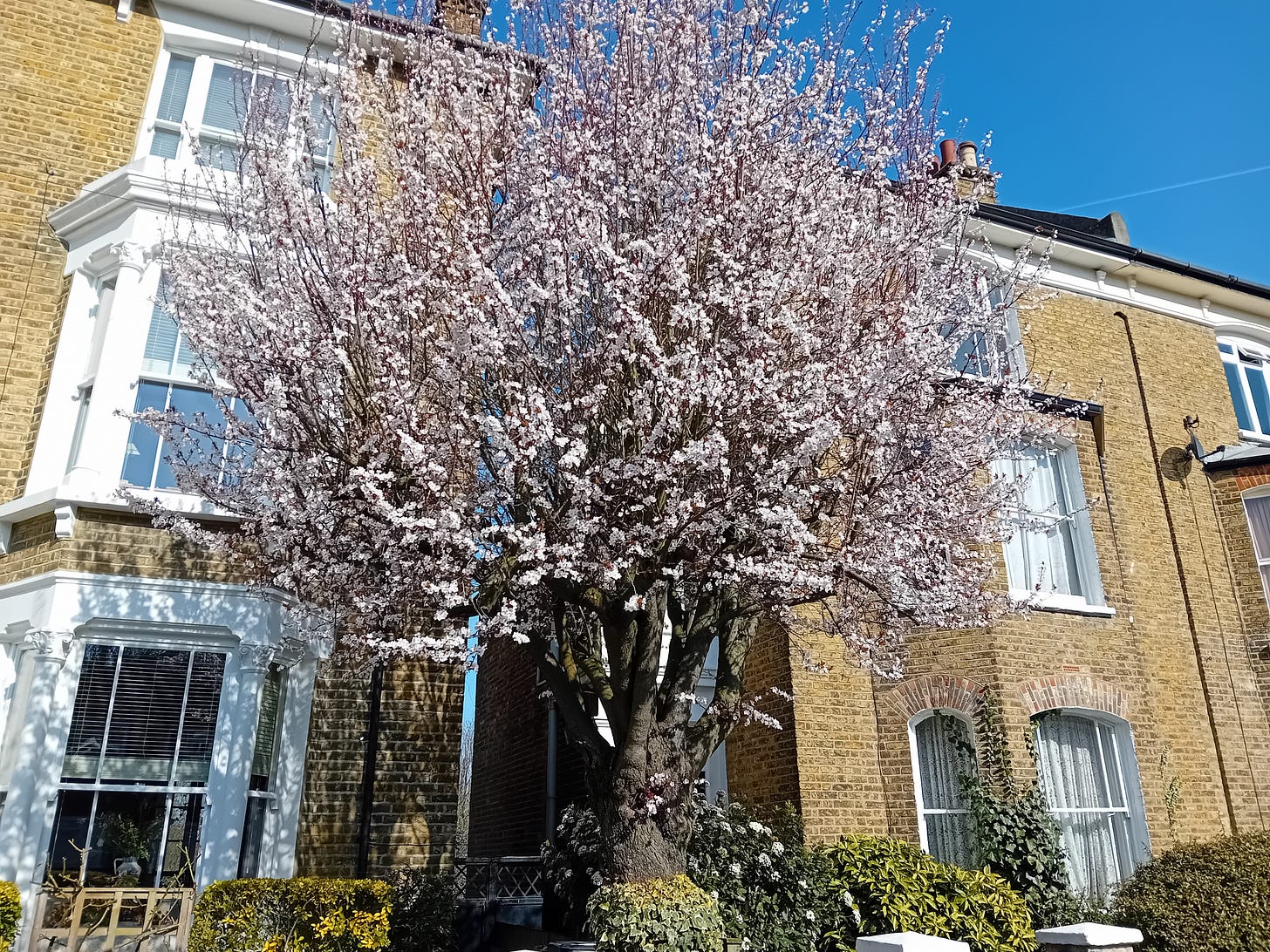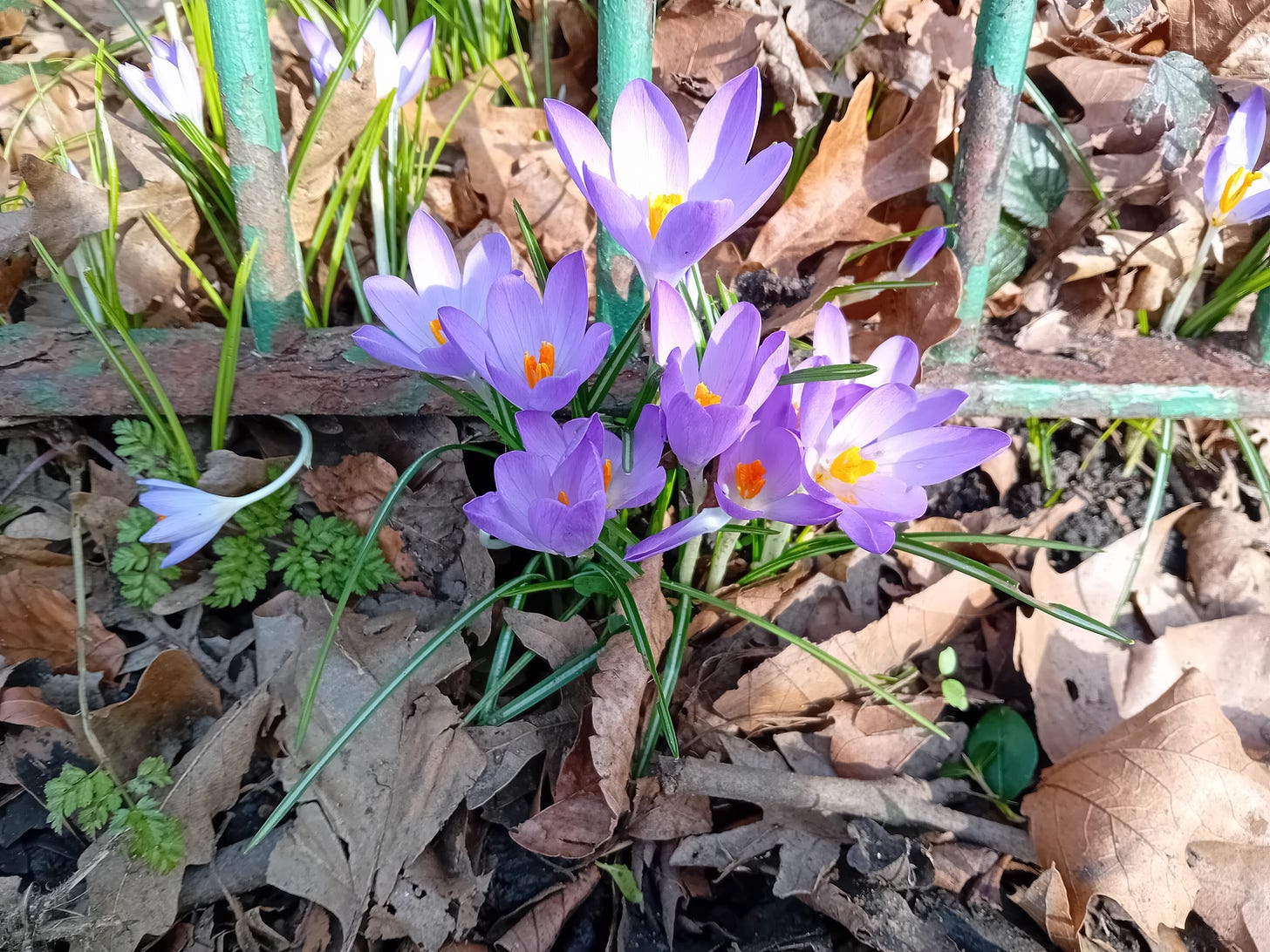Spring is in the air
On signs of Spring, and what science and superstition tell us about Peacock butterflies
Have you seen any butterflies yet this year? Last year, I saw my first butterfly of the season – a Brimstone - on 15 February, so I’ve been keeping an eye out for them over the last few weeks, particularly since the start of the succession of warm, sunny days we’ve had recently. And I spotted my first butterfly of 2025 while out for a walk in Epping Forest on 2 March. Even though it was darting about so quickly that I didn’t get a chance to take a photo, the distinctive ‘eyes’ on its orange-red wings made it easy to identify as a Peacock.
Peacocks are one of the UK’s most common species of butterfly – we often see them on our transect at One Tree Hill – and they hibernate in this country over the winter so it’s not particularly unusual to see them on the wing as soon as the weather warms up. But it was lovely to see it nevertheless. Despite the fact that the primroses in my garden have been flowering for weeks, the parks are full of crocuses, and I’ve already heard a woodpecker drumming in the tall trees on the railway embankment a few times, it is only after seeing a butterfly on the wing, that I can truly believe Spring is under way.
Last Autumn, I went to a conference organised by the Big City Butterflies project. Among the many fascinating pieces of information I learnt that day was that although people have been studying butterflies for hundreds of years and have learnt lots of fascinating details about them, there is still much that we don’t know. For example, even though it’s well-known that the eyespot patterns on the Peacock’s wings help it to ward off predators, no-one knows for certain why this feature is so effective. Are birds simply deterred by the sight of the ‘eyes’ suddenly appearing when a Peacock at risk of attack flicks open its wings? Or do the eyes actually cause predators to mistake the butterfly for something that might pose a danger to them such as an owl?
Peacocks also have another tactic they can use to defend themselves - a hissing noise they create by rubbing the veins on their hindwings and forewings together. This has been shown to deter mice and is particularly important when Peacocks are hibernating in darkness. This is a time when they are vulnerable to being eaten by foraging mice and other small mammals, but their eyespots are useless because they can’t be seen in the dark.
The Peacock’s ability to defend itself in various ways has led to it being described as ‘the toughest UK butterfly’ by Dr Richard Fox of Butterfly Conservation. There is lots of folklore and superstition associated with butterflies too and apparently, some people believed that butterflies with ‘eyes’ on their wings were God’s spies. I prefer the scientific explanation for the eyespots but at least if Peacocks are spies they have lots of mechanisms for defending themselves against their enemies.
Thinking about butterfly sightings and signs of Spring reminded me of this piece which I wrote for Spelt Magazine a few years ago.
Spring signs and hopes
Rat-tat-tat. I turn and scan the branches overhead, but the drumming immediately stops, and I can’t tell exactly where it was coming from. As soon as I turn away, there it is again – rat-tat-tat – and again it stops when I turn to look. This happens a few times before I grow bored of the game and walk on. Of course, the woodpecker isn’t playing games, just getting on with life. And all around me, there are more sights and sounds of life as buzzing insects and blackthorn blossom proclaim the arrival of spring in Spring Wood. Surrounded by trees and with birdsong obscuring the sound of traffic, I already feel miles away from the busy high street I walked along a few minutes ago.
The names of many of the nearby streets - Woodland Way, Copse Avenue, Oaklands Avenue - bear witness to the fact that this whole area was once covered in trees. Spring Wood and the adjoining wood somehow survived the area’s development, the boundary between them now marking the border of two London boroughs as well as a change of ownership. My destination today is neighbouring Threehalfpenny Wood which got its name when a man’s body found in the pond could only be identified by the three ha’pennies in his pocket, or so the story goes.
I’m here with Croydon TCV (The Conservation Volunteers) on one of our regular visits to help replicate the kind of woodland management that would have been carried out for centuries before the wood became a source of suburban solace rather than fodder and firewood. Our main task is thinning out the holly as there’s so much of it in some places here that it is stopping sunlight from reaching the woodland floor. Removing smaller holly trees and the lower branches of larger ones will give the bluebells and other woodland flowers more chance to grow. It’s scratchy but deeply satisfying work.
After an hour or so we stop for a tea break and it’s then while chatting to some of the other volunteers that I spot a splash of bright orange among the dark brown roots of an upturned tree. Initially I mistake it for a small piece of wind-blown plastic. Then I realise it’s a Comma butterfly, basking in the sunshine. With its wings open, I can’t see the comma shape on the underwing for which its named, but I recognise the distinctive bumpy edge to its wings. Soon afterwards I spot a yellow Brimstone flitting through the clearing.
These are my first butterfly sightings of the year. Both are among the few species which overwinter in the UK as adults, so they’re often the first to appear when the weather warms up. It’s a delight to see the butterflies flying again – a sign that spring really is on the way – but my pleasure is mixed with concern that an unusually sunny March may have led them to emerge too early. And when it turns really cold again just two weeks later and the first of the April showers fall as sleet and snow, I worry even more for the butterflies.
According to folklore, seeing an orange butterfly is said to be a sign of joy ahead something that’s sorely needed in the world right now. I don’t know whether it’s due to the butterfly sightings, the effect of all that physical activity or simply the hours spent among the trees, but I do know I am feeling a lot more hopeful by the time we finish for the day. On my walk home I pause for a moment to capture that feeling before I step out of the woods and return to the city once more.
First published in Spelt Magazine Issue 5, May 2022
I looked into the superstitions associated with butterfly colours again recently and realised that most sightings seem to be something of a mixed blessing. That must be particularly true of the Peacock with it’s mix of different colours. Red butterflies are said to bring warnings so I hope the red-orange Peacock wings I saw were warning me that joy is on its way.
To finish….
…a few things I’d like to share:
SOIL at Somerset House: Art and science combine in this fascinating exhibition which explores what goes on in the soil beneath our feet, and just how vital this is for life above ground. One of the most impressive exhibits was a film showing time-lapse recordings of what goes on underground. It was amazing to see just how much activity there is.
The beavers really are back: There are already a lot of beavers living wild in England, either because they have escaped or have been released unofficially. But until recently anyone wanting to re-introduce beavers in England was legally required to keep them contained within fenced enclosures. That changed at the end of February when the Government legalised the release of beavers into the wild and now the first legal release has taken place in Dorset. Some good news for the natural world at last.
Encounter App: I’m enjoying using this app which was set up by Melissa Harrison who, among many other things writes the wonderful Witness Marks on Substack. Encounter provides a great way of easily recording what you experience in the natural world. You can add photos and short descriptions to keep a record of your experiences and it also includes lots of articles and information to help you learn more about what you’re likely to see at different times of year.





love the bit about orange butterflies and joy! thank you for lovely piece
It's lovely to see signs of Spring! i haven't seen any butterflies yet this year, but I've been hearing Great Spotted Woodpeckers drumming for a couple of weeks now.